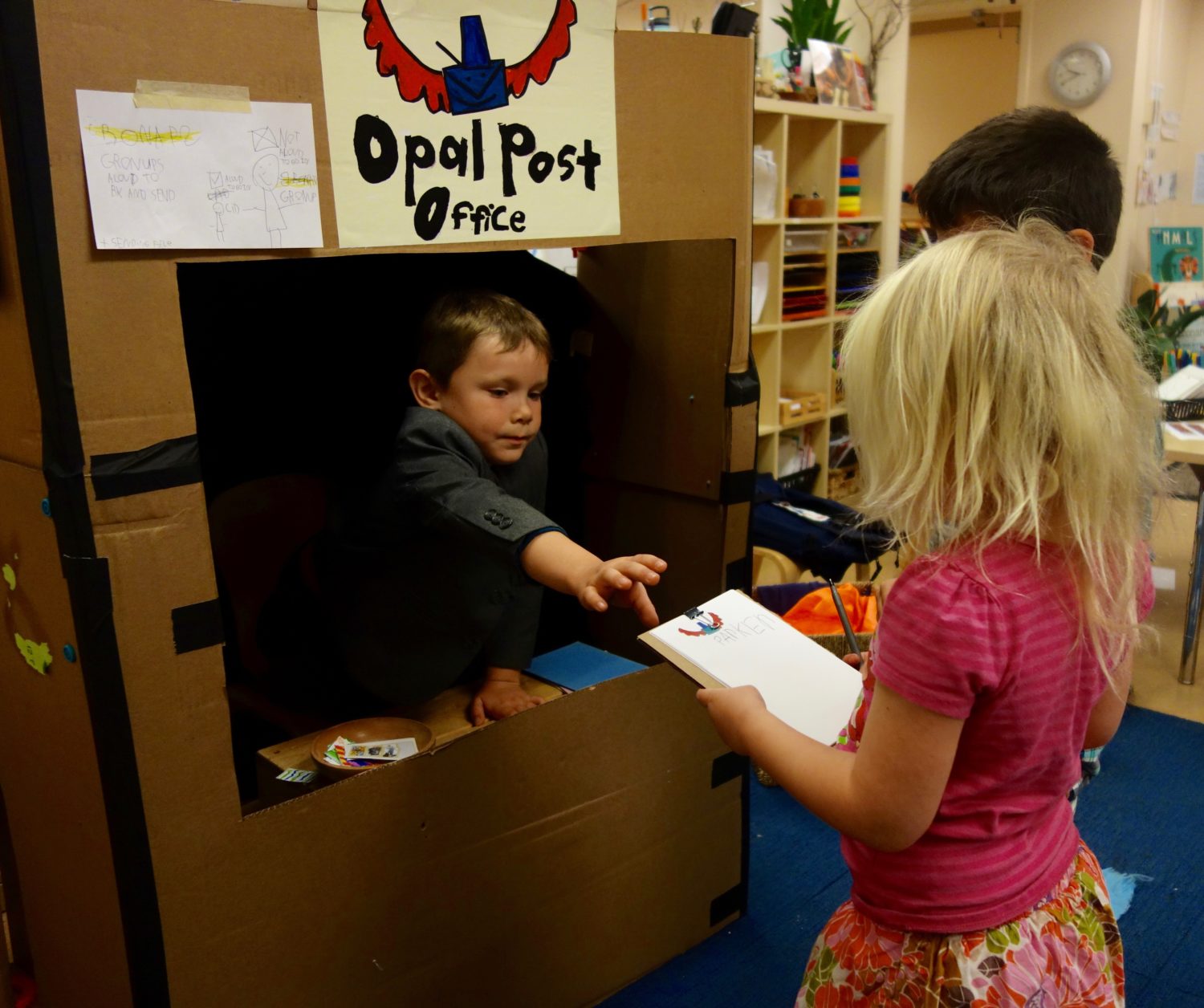Inventiveness emerges through the tangles found in play

At a recent meeting Opal teachers were asked to reflect on the ways invention has emerged in their respective learning communities this year. Using a resource describing dimensions of invention education at Opal School crafted with Project Zero’s Ben Mardell and Mara Krechevsky (who will be sharing this work at our Summer Symposium), we revisited the many ways that we have seen the children practicing inventiveness this year.
Currently the Cottonwood community of kindergartners and first-graders is in the heart of project work. Our post office is in the middle of construction, we have committees making daily decisions on how we need to move forward with various aspects of the post office, and we are in the midst of sharing necessary information with the other learning communities at Opal School so that they too can send and receive mail through our postal system. So, as we were reflecting on invention this year, my focus naturally went to the mail system and where inventive thinking has emerged thus far.
One principal of invention education specifically stood out to me:
Invention education at Opal School embraces play as a strategy for learning. Thomas Henricks says, “Play is not a flight from the world; it is inquiry into the challenges and responsibilities of social living.” Children are encouraged to play with ideas in ways that provide low-stakes opportunities to practice inventiveness. Saying “yes” to play and playfulness enhances the likelihood of an “inventive disposition” in dealing with life’s challenges.
Play has been essential to moving us forward as a community towards a fully operational post office. So much so, that one of our post office committees is the “Dramatic Play Committee.” Children signed up to go to dramatic play during project work and use dramatic play as a way of uncovering more about the mail system and moving our work forward. Through dramatic play, the children have encountered tangles and uncertainties as they become postal workers and mail recipients. As described above, dramatic play offers the children a “low-stakes opportunity to practice inventiveness” when they encounter these tangles.
One specific tangle that I observed recently in dramatic play happened when the children were building mailboxes for their house, so the letter carriers from the post office would have a space to drop off mail. As a prop, we have some empty boxes for the children to use. As Amanda was building a mailbox, the children realized that it was too small to fit packages inside.
Derek (building a chimney on the roof of the house): This is what the steam comes out of.
Amanda (building a mailbox in the front of the house): The mailbox has to face this way so the mail person can put the mail in.
Michael (points at Parker’s chimney): And this is the chimney! Wait! How about packages come here? (pointing to the chimney) They won’t fit in Amanda’s box!
Derek: Oh yes. Yes, yes!
Amanda: And you just put your mail in…our mail in the steam thing.
Michael: Yeah, let’s just put packages down the roof.
Here, the children encountered a problem. Their packages were too big to fit in the mailbox that they had constructed. Through play, which provided a low-stakes opportunity for problem solving, the children invented a system that worked for them in that moment; envelopes would go into the mailbox and packages would be dropped down the chimney. The system that these children constructed in dramatic play was temporary for the duration of our project work time. However, the core issue of packages being too large to fit in the mailbox is one that may have larger implications for our postal system.What happens if someone in Opal School wants to mail a package that is too large to fit in the mailboxes that we have created for each classroom? What system will we invent together to remedy this problem?
It is unlikely that dropping packages down the chimney at Opal School will be the solution that we land on. However, I am curious how grappling with this problem in dramatic play will support us later to approach it, within the constraints of our actual postal system, with an inventive disposition. Specifically, how did dramatic play set the children up to encounter this natural problem? And how will having remedied this problem in the low-stakes context of dramatic play help us later when we encounter a tangle in our actual mail system?
More broadly, as a teacher this principle of invention education at Opal School has led me to wonder about the many tangles that children encounter while absorbed in play each day. What other instances of inventiveness are arising in seemingly small moments throughout the day? Where else do I see play providing low-stakes opportunities for children to invent solutions? And how are the solutions that children invent while absorbed in play informing problem solving in other areas of their lives?
Where do you see play providing low-stakes opportunities for inventiveness in your classroom?
What moments stand out to you as times you have seen play supporting children to approach problems with an inventive disposition?
